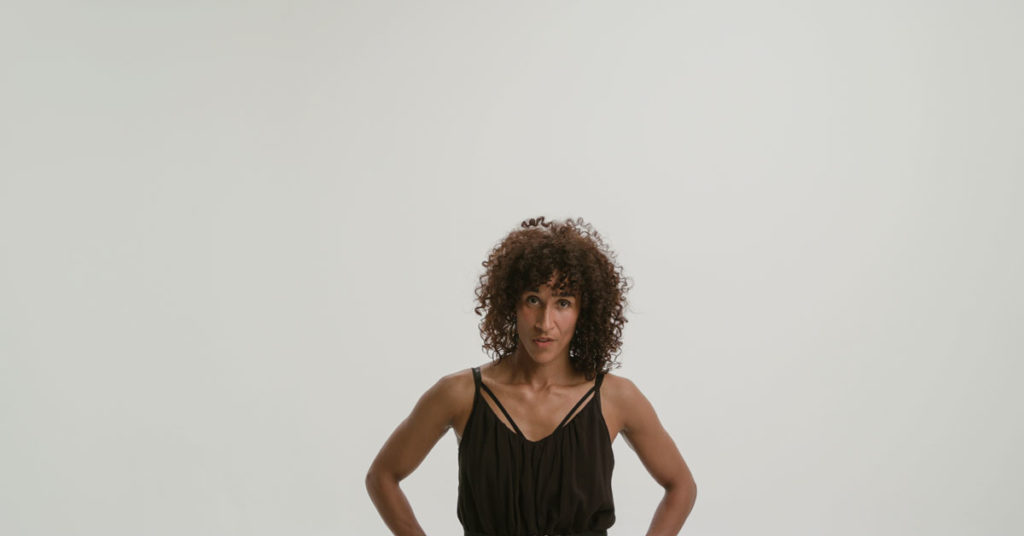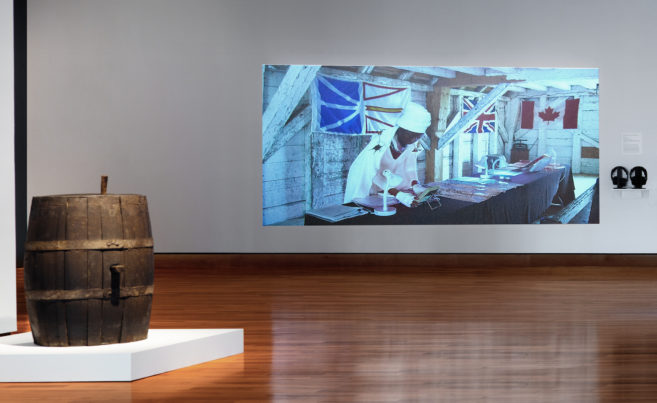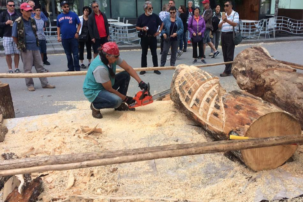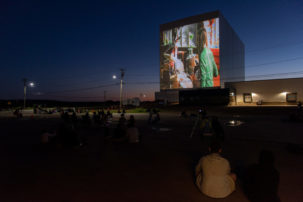To live in Canada as a Black person is to live at the intersection of several anxieties. Subtle and overt racism pervades the Black experience in this country but is frequently belittled as less abrasive than its southern counterpart. Meanwhile, we’re overshadowed by that monolithic American idea of Blackness. Black Canadian histories and cultural contributions are nearly absent within the national imaginary, and this volatile mixture of racism and erasure impacts our daily existence and influences our artistic practices.
When entering “Here We Are Here: Black Canadian Contemporary Art” at the Royal Ontario Museum, I see Michèle Pearson Clarke’s Suck Teeth Compositions (After Rashaad Newsome) (2018) first. The looping, three-channel video installation builds a repetitive “choral symphony” of sounds–of sucking teeth, exhaling, silence and ruffling–that permeates throughout the entire space. One woman, who says the installation is annoying, finds the symphony so jarringly irritating that she has to leave the gallery. What she’s probably oblivious to are the microagressions and anti-blackness that Black people in Canada stomach daily, and how aggravating they can be. Sucking one’s teeth is a gesture rooted in discomfort, and it is used across the West African diaspora to express frustration and anger–especially when it’s an overt risk to express those sentiments vocally.
Even when out of view, Clarke’s Suck Teeth Compositions is heard throughout the gallery, which forces even those using the exhibition as conduit between one area and the next to engage with it. It uses codes and gestures that are instantly familiar to any children of the diaspora who have ever had to witness their mothers biting their tongues in the face of white authority. Through this cultural habit, Clarke shows a multiplicity of Black life.
Similarly, the works by the eight other artists in “Here We Are Here” are neither appeasing nor easily digestible. There are no easy answers here. Despite the wide range of media used–video, installation, painting, photography, sculpture–the exhibition is ultimately cohesive because the works selected defy classification in the same way Blackness defies a single universal experience.
The exhibition is wedged between the entrances to two permanent exhibitions: the Gallery of Byzantium and the European Galleries. Whether intentional or not, this location informs how “Here We Are Here” is experienced, and the exhibition has the daunting task of moving Black people and Black art from the periphery of Canada’s cultural consciousness to its centre. The ROM’s curator of African arts and cultures Silvia Forni and guest curators Julie Crooks and Dominique Fontaine critique the way in which Black Canadians are constantly positioned as immigrants or newcomers; this is a commonplace assumption based on a legislated multiculturalism that maintains the perception of this population as “other” by actively contributing to the erasure of Canada’s Black history. The curators successfully expand a conversation about whose work is considered naturally “Canadian” and whose work belongs in spaces like Canada’s art and history institutions.
Omissions from Canadian history have framed the country as a sanctuary. We’re proud of the Underground Railroad and learn stories of Black people fleeing American bondage for Canadian freedom, though we are unlikely to learn about a 1911 Order-in-Council signed by Prime Minister Wilfrid Laurier that for one year prohibited “any immigrants belonging to the Negro race, which race is deemed unsuitable to the climate and requirements of Canada.”
The backlit fabric panel with printed archival text that comprises Sweet Childhood (2017) by Bushra Junaid highlights the little-known commodity trade system developed between Newfoundland and the Caribbean for and by enslaved Africans. She superimposes advertisements for sugar and rum from the St. John’s Evening Telegram over the bodies of two young children in a cane field. In an explanatory video installed elsewhere in the gallery, Junaid suggests, “Canada’s great legacy is our capacity for erasure.”
At this point in the ongoing struggle towards reconciliation and decolonization BIPOC are openly and widely questioning the roles institutions have in maintaining the status quo. The ROM is still addressing mistakes made in its 1989 exhibition “Into the Heart of Africa,” which was widely regarded as an exploitative celebration of colonialism. Since 2013, Crooks and Fontaine have been working with Forni to curate “Of Africa,” a multiplatform series that pluralizes representations of Africa and its diasporas. “Here We Are Here” counters the mistakes made in “Into the Heart of Africa” by showing that when community members and Black curators are involved and consulted, exploitation can be mitigated.
The namesake of the whole exhibition, Sylvia D. Hamilton’s installation Here We Are Here (2013–17) weaves her personal history in Atlantic Canada with the collective history of Black people in this country. The ambitious, multidisciplinary work challenges ideas about Canada’s colonial past. Lists descend from the ceiling with hundreds of names of enslaved Black people, free Loyalists and free refugees who settled in Nova Scotia as far back as 1749, including Hamilton’s direct ancestors. The lists are so long that they roll into themselves. A soft voice recites the names, speaking their identities into existence, asserting their presence in the space. Hamilton compiled the list herself, collecting names from the public archives of Nova Scotia, T. W. Smith’s The Slave in Canada (1899), Sir Guy Carleton’s Book of Negroes (1783) and the Black refugee list from the War of 1812. In a glass case, Hamilton uncovers neglected parts of our history, presenting a collection of trinkets depicting blackface and a notice demanding a runaway slave be returned to her master in Nova Scotia. Because so many Canadians are still unaware that slavery existed here, naming names and recovering overlooked historical artifacts is important for combatting erasure in our collective memory.
During the artists’ talk for “Here We Are Here,” Clarke mentioned being referred to as a “Black artist” versus as an “artist,” a recurring conversation among artists from many marginalized communities. Racial identity needn’t be constantly referenced with or related to an artist’s work and, thankfully, the ROM exhibition runs well beyond the confines of the 28-day-long Black History Month, which is often a very tokenizing period for Black artists and creators because they are usually approached only during this time of year. “Here We Are Here” manages to assert the relevance of Black people in Canada’s past, present and future.
Esmaa Mohamoud’s wearable sculpture Untitled (No Fields) (2018) links the past and the present by bringing the bondage of the transatlantic slave trade and subsequent, continued degradation of Black people into a modern context. The football gear, adorned with a West African print and a cape of chains weighing it down, stands alone on astroturf painted black. Mohamoud’s practice explores how the sports industry controls Black men and their bodies. Inspired by the vile reaction to Colin Kaepernick taking a knee in defiance during the American national anthem, the sculpture is representative of the burden often placed on Black men in sport.
Chantal Gibson explores similar themes in Souvenir (2017), for which she collected 2,000 copper, pewter and silver souvenir spoons and spray-painted them matte black. From afar, all the spoons seem homogenous; only if you step over the white museum tape and look closer do the minute details and engravings (obscured by the uniform paint) become visible. The spoons’ individualities have been erased while simultaneously creating a shared, collective blackness, suggesting that Black people’s individual identities are often subsumed to the notion of a monolithic “universal Blackness.”
Sandra Brewster’s Hiking Black Creek (2017) monumentalizes a photograph of her parents on their first hike after arriving in Canada. Initially, it reads as a photograph from their family collection blown up and mounted on wood. Later, it becomes clear that by making her parents a larger than life presence in the gallery, Brewster is placing them and their personal history into the context of the museum, which serves as a gesture towards resisting erasure.
The French title of the show “Nous sommes ici, d’ici” directly translates to “We are here, from here,” with an emphasis on “from” demanding that Black Canadians be viewed not as apart from, but as a part of the Canadian national identity. In both subtle and apparent ways, all the artists in the exhibition demand that a multiplicity of Black diasporic experiences are intrinsically perceived as an integral part of Canadian contemporary art.
“Here We Are Here: Black Canadian Contemporary Art” Includes work by Sandra Brewster, Michèle Pearson Clarke, Chantal Gibson, Sylvia D. Hamilton, Bushra Junaid, Charmaine Lurch, Esmaa Mohamoud, Dawit L. Petros and Gordon Shadrach. The exhibition continues at the Royal Ontario Museum until April 22, 2018. It will be on display at the Montreal Museum of Fine Art from May 12 to September 16, 2018.









